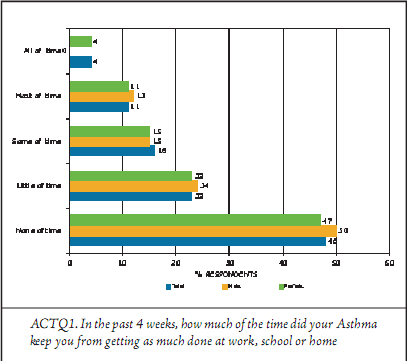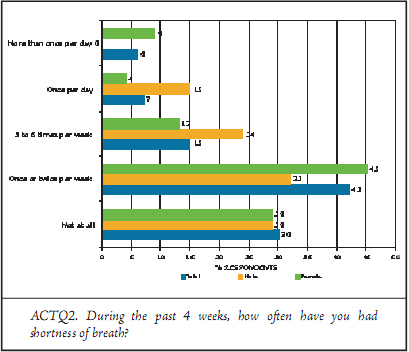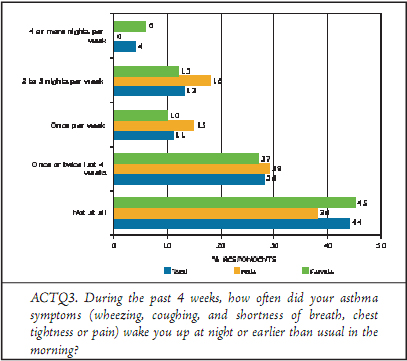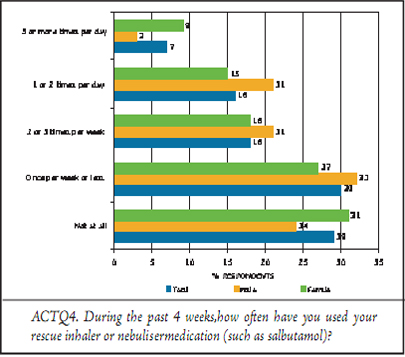Level Control of Asthma Patients in Chest Specialist Clinics
Nasser Al Busaidi, Suad Al Mukhaini
Al-Busaidi N, et al. OMJ. 24, 195-198 (2009); doi:10.5001/omj.2009.38
ABSTRACT
Objectives: This survey aims to assess the current levels of asthma control as reported by patients attending chest specialist clinic by using the Asthma Control Test (ACT) questionnaire.
Methods: Current levels of asthma control were assessed using the ACT questionnaire, and a brief instrument developed to assess asthma control in a clinical setting. 141 (100 females) patients aged 13 years and above were recruited from the chest clinic of Royal hospital, a tertiary hospital in the Sultanate of Oman. The ACT questionnaire was administered only from the second visit.
Results: The result showed that 61% of patients scored between “20 and 25” (well controlled), 17.7% of the patients scored between “15 and 19” (not well controlled), and the rest 21.3% scored between “5 and 14” (poorly controlled). More than 50% of the patients reported that their asthma had an impact in work, school or home Nocturnal symptoms were reported by 66% and the use of rescue medications by 70%. Patient perception of asthma control did not match their symptom severity as more than 65% considered their asthma controlled despite the fact that their symptoms limited their daily activities and disturbed their sleep.
Conclusion: The current level of asthma control among the study patients falls far short of the goals for long-term asthma management and patients’ perception of asthma control is different from their actual asthma control.
From the Department of Chest Medicine, Royal Hospital, Muscat, Oman.
Received: 27 May 2009
Accepted: 15 June 2009
Address correspondence and reprint request to: Dr. Nasser Al-Busaidi, Department of Chest Medicine, Royal Hospital, Muscat, Oman.
E-mail: enhsa@hotmail.com
INTRODUCTION
Asthma is a serious global health problem. People of all ages in countries throughout the world are affected by this chronic airway disorder that, when uncontrolled, can place severe limits on daily life. Asthma is a significant burden, not only in terms of health care costs but also in terms of lost productivity and reduced participation in family life. The prevalence of asthma is increasing in most countries. Guidelines (GINA) for the management of asthma state that the therapeutic aim should be to achieve overall asthma control in order to minimize the impact of asthma on the individual patient.1 ,2, 3
Several questionnaires have been developed to measure asthma control, such as, the Asthma Control Test (ACT). Assessment of health-related quality of life (HRQoL) alongside conventional clinical monitoring is increasingly proposed as a means of aligning patient expectations with the clinician’s therapeutic goals.4
ACT may directly correlate with HRQoL because it includes questions on symptoms, daily activities, and uniquely, a self-assessment of asthma control, which may all affect HRQoL. In a recent report from China ACT was found to have the maximum internal consistency reliability and correlation with physician rating when compared with two other questionnaires.5 Asthma Control Test reflects the symptoms and activity themes of asthma quality of life well.6
Schatz et al. reported a good correlation between the use of systemic steroids and regular follow up with specialist and the score of ACT.7
In a study assessing the reliability and predictive validity of ACT a score of 15 was associated significantly with an increased 12 month risk of emergency hospital care, oral corticosteroid dispensing and dispensing of more than 6 beta-agonist canisters compared with a score of 20.8 This survey assessed the current levels of asthma control as reported by patients attending chest specialist clinic by using Asthma Control Test (ACT) questionnaire.
METHODS
Patients who follow up in Respiratory Out Patient Department; Royal Hospital, Sultanate of Oman formed the study population. Diagnosis of asthma in these patients was made by either prior physician diagnosis where an alternative diagnosis was not found and the patient showed a good response to steroid inhalers or the diagnosis was confirmed by a significant reversibility in Forced Expiratory Volume in first second (FEV1) or in Peak Expiratory Flow Rate (PEFR). These patients were seen at least once in same clinic prior to administering the ACT Questionnaire. These patients also should have taken their inhalers regularly for at least two months before entering the study. Patients with pre-existing cardiac failure, chronic obstructive airways disease and bronchiectasis were excluded.
The patients answered the questionnaire which was in English with the help of the treating physician in the chest clinic. The ACT questionnaire covered 4 dimensions of asthma control (activity limitations, dyspnea, nocturnal awakenings, and rescue medication use) and also assesses patients’ perception of control. The scores of each item are summed for a total score (5-25), with lower scores indicating poorer control. A score of 19 or less indicate inadequately controlled asthma. ACT has been well validated in many studies
RESULTS
The total number of patients included in the study 141 patients; 100 were female, the age of the patients ranged between 13 and 82 years, the severity of their asthma ranges between mild persistent asthma and severe asthma.
The result showed that 61% of patients scored between “20 and 25” (well controlled), 17.7% of the patients scored between “15 and 19” (not well controlled), and the rest (21.3%) scored between “5 and 14” (poorly controlled).
More than 50% of the patients reported that their asthma has an impact in work, school or home duties ranging from all the time 4% to; little of time 23%. Only 30% of the patients reported in the last 4 weeks have no shortness of breath, the rest have short of breath ranging from once or twice per week 42% to more than once per day 6% (Fig. 1 & 2).

Figure 1: Results for ACTQ

Figure 2: Results for ACTQ2
Nocturnal symptoms are common with asthmatic patients; in the study patients, only 44% they reported having no night symptoms in the last 4 weeks, the rest of the patients asthma disturbs their sleep ranging from 2 to 3 times waking up per night in 4% to once to twice in the last 4 weeks in 28% (Fig. 3).

Figure 3: Results for ACTQ3
The use of rescue medications was very high among the study patients as more than 70% reported the use of rescue medications in the last 4 weeks, while 23% used rescue medications 2-3 times per day, and only 30% reported that they had not used any rescue medications in the last 4 weeks. (Fig. 4)

Figure 4: Results for ACTQ4
The perception of asthma control among the study patients did not reflect their asthma symptoms, disturbance of the sleep or disturbance of the work or the amount of the rescue medications they used as more than 65% of the patients reported that their asthma was controlled, ranging from completely controlled (26%) to well controlled 40% of the patients (Fig. 5)

Figure 5: Results for ACTQ5
DISCUSSION
This study showed that asthmatic patients who followed up with a chest specialist were not adequately controlled in terms of their symptoms. Around 40% of the patients had either not well controlled or poorly controlled asthma. This finding is consistent with the findings of Peters et al. in the REACT study, where they reported that 55% of the patients had uncontrolled asthma.9
The findings from this study are similarly reported by Schmier et al. who reported that more than half of their patients were inadequately controlled as assessed by ACT.10 Lenoir also reported that a considerable portion (43%) of subjects with self-reported asthma in the general population was identified with not well controlled asthma.11 Laforest et al. also observed similar results in a community pharmacy-based survey and reported that asthma control was satisfactory for only 28% of the patients during a four-week period.12
In this study, more than 50% of asthmatics reported that their asthma had an impact on work, school or home duties, considerably more than what was reported in AIRE where only 37.9% of adults reported that their asthma impaired their normal physical activities.13
Nocturnal symptoms were common among the study patients; 66% reported having night symptoms in the last 4 weeks, which is more than what was reported in the AIRE study where only 36.2% of the adult asthmatic patients had disturbed sleep as a result of uncontrolled asthma symptoms.13
The use of rescue medications was very high among the study patients, more than 70% reported the use of rescue medications in the last 4 weeks, which is much higher than what was reported in the AIRE study where 63.6% of the adult patients reported the use of rescue medications in the last month.13
The perception of asthma control among the patients was not reflected in their asthma symptoms, disturbance of sleep or work or the amount of rescue medications they used, as more than 65% of those who reported that their asthma as controlled ranged from completely controlled (26%) to well controlled (40%) which is more or less the same as the AIRE study, and despite the high frequency of asthma symptoms, acute health care visits and activity limitations reported in the survey, 65.9% of adults said they had no asthma symptoms or only mild asthma during the past four weeks.13
CONCLUSION
This study highlighted the gap between the long-term goals of asthma management, as set by the Global Initiative for Asthma (GINA). The goals set by GINA are not currently being met, and patients and their doctors may be complacent about the level of asthma control being achieved.
It is crucial therefore, that public health and health authority resources and educational efforts are targeted to improve asthma control and reduce the disease burden on both the health care system and the society.
ACKNOWLEDGEMENTS
The authors reported no conflict of interest and no funding has been received on this work.
-
Global Initiative for Asthma (GINA). Global strategy for asthma management and prevention. NHLBI/WHO workshop report. National Institutes of Health, National Heart, Lung and Blood Institute. January 1995, NIH, publication number 95±3659.
-
Global Initiative for Asthma (GINA). Global strategy for asthma management and prevention: NHLBI/WHO. Workshop Report (publication No. 02-3659). Bethesda, National Institutes of Health, National Heart, Lung, and Blood Institute, 2002.
-
National Asthma Education Prevention Program. Guidelines for the diagnosis and management of asthma. Expert panel report 2 (publication No. 97-4051). Bethesda, National Institutes of Health, National Heart, Lung and Blood Institute, 1997.
-
Juniper EF. The impact of patient compliance on effective asthma management. Curr Opin Pulm Med 2003; 9: Suppl. 1, S8–S10.
-
Zhou X, Ding FM. Validity of Asthma Control Test in Chinese patients. Chin Med J (Engl), 2007; 120: 1037-41.
-
Schatz M, Mosen DM. The relationship between asthma-specific quality of life and asthma control. J Asthma. 2007; 44:391-5.
-
Schatz M, Mosen DM. Predictors of asthma control in a random sample of asthmatic patients. J Asthma 2007; 44:341-5.
-
Schatz M, Mosen DM. Reliability and predictive validity of the Asthma Control Test administered by telephone calls using speech recognition technology. J Allergy Clin Immunol 2007;119:336-43.
-
Peters SP, Jones CA, Haselkorn T, Mink DR, Valacer DJ, Weiss ST Real-world Evaluation of Asthma Control and Treatment (REACT): findings from a national Web-based survey. J Allergy Clin Immunol. 2007;119:1454-61. Epub 2007 May 3.
-
Schmier JK, Manjunath R, Halpern MT, Jones ML, Thompson K, Diette GB. The impact of inadequately controlled asthma in urban children on quality of life and productivity. Ann Allergy Asthma Immunol. 2007; 98:245-51.
-
Lenoir M, Williamson A, Stanford RH, Stempel DA. Assessment of asthma control in a general population of asthmatics. Curr Med Res Opin. 2006; 22:17-22.
-
Laforest L, Van Ganse E, Devouassoux G, Chretin S, Bauguil G, Pacheco Y, Chamba G. Quality of asthma care: results from a community pharmacy based survey. Allergy. 2005; 60:1505-10.
-
K.F. Rabe, P.A. Vermeire, J.B. Soriano+, W.C. Maier. Clinical management of asthma in 1999: the Asthma Insights and Reality in Europe (AIRE) study. Eur Respir J 2000; 16: 802±807.